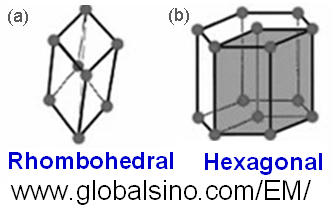|
This book (Practical Electron Microscopy and Database) is a reference for TEM and SEM students, operators, engineers, technicians, managers, and researchers.
|
=================================================================================
Close-packing of equal spheres (e.g. the same atoms in a crystal) can form the trigonal, hexagonal or cubic crystal systems. The structure belongs to the trigonal system if the structure has the minimum symmetry, while it belongs to the hexagonal system if it has a 63 axis of symmetry.
Table 3549a and Figure 3549 show the trigonal crystal systems (in orange) and the schematic illustrations of the trigonal lattices, respectively. As indicated in Table 3549a, the structures belonging to the trigonal system can have either a rhombohedral or hexagonal lattice. Both the hexagonal (with 6-fold symmetry) and the trigonal (with 3-fold symmetry) systems require a hexagonal axial system. The trigonal system has the rhombohedral unit cell as an unique feature. In this case, the smallest primitive cell may be chosen with a = b = c, α = β = γ ≠ 90°. Furthermore, Table 3549c shows the cell edges and angles of trigonal crystals.
Table 3549a. Trigonal crystal systems.
Crystal
family |
Crystal
system |
Required
symmetries
of point group |
Point
group |
Space
group |
Bravais
lattices |
Lattice
system |
| Hexagonal |
Trigonal |
1 three-fold axis of rotation |
5 |
7 |
1 |
Rhombohedral |
| 18 |
1 |
Hexagonal |
| Hexagonal |
1 six-fold axis of rotation |
7 |
27 |

Figure 3549. Schematic illustrations of the Bravais lattices of trigonal crystals: (a) and the grey cell in (b).
Table 3549b. Relationship between Laue classes and point groups.
| System |
Essential symmetry |
Lattice symmetry |
Laue class (Diffraction symmetry) |
Point Groups (Hermann–Mauguin notation) |
| Triclinic |
None |
 |
 |
1, -1 |
| Monoclinic |
 |
2/m |
2/m |
2, m, 2/m |
| Orthorhombic |
222 or 2mm
|
mmm
|
mmm |
222, mm2, mmm |
| Tetragonal |
 |
4/mmm
|
4/m
|
4, -4, 4/m |
| 4/mmm |
422, -42m, 4mm, 4/mmm |
| Trigonal |
 |
 |
3 |
3, -3 |
| -3m1 |
321, 3m1, -3m1 |
| -31m |
312, 31m, -31m |
| Hexagonal |
 |
6/mmm
|
6/m |
6, -6, 6/m |
| 6/mmm |
622, -62m, 6mm, 6/mmm |
| Cubic |
23 |
m3m
|
m-3 |
23, m-3 |
| m-3m |
432, -43m, m-3m |
Table 3549c. Other characteristics of trigonal structures.
Contents |
Page |
| Angles in unit cells |
page3555 |
| Volume of unit cells |
page3033 |
| Bravais lattices |
page4546 |
| Relationship between three-dimensional crystal families, crystal systems, space group, point group, lattice systems and symmetries |
page4549 |
|
